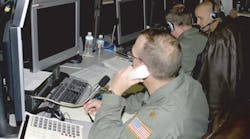by Duncan Young
"COTS - short for commercial off-the-shelf - has been around as a practical means of implementing embedded systems for at least 15 years now. In the embedded real-time computing segment of our marketplace the genesis of COTS could be seen in the first offerings of non-developmental items (NDI) in the form of rugged off-the-shelf Multibus and VMEbus cards from a number of vendors. However, the COTS movement really took off in 1995 with the great changes of the Perry era and turned into today's success story by continuous innovation and evolutionary change as vendors reacted to issues such as component obsolescence, lifecycle management, and technology insertion.
COTS must continue this process of development as our customers' expectations and needs change. So, what then is the right direction? Is it reasonable just to consider the potential proliferation of blade-server technology in the Navy to generalize about the direction of COTS today or is this just part of COTS' natural evolution? I would argue that COTS should and will follow the directions dictated by customer need and the growth of alternate technology solutions and cannot be constrained by what we only know as good today ... but, whether its blade servers or military-grade computers, deployed COTS has to be maintainable, affordable, and, above all, must remain mission-effective throughout its required lifetime. What other criteria should we use to judge COTS' future directions?
COTS can be applied equally to hardware, software, or even a complete system. It is not a description of the value or provenance or ruggedness of a piece of equipment; it is a methodology for procurement of the most appropriate items to perform the required function in a system. COTS procurement is about making effective use of components, assemblies, software, subsystems, and systems that are commercially available, which might, if correctly selected, facilitate the construction of an end-use system application.
COTS doesn't replace the need for requirements capture, decomposition, and system analysis. If these are ignored a COTS-based procurement will inevitably fail. Only when the functional and performance requirements of the system have been properly captured, can the next steps of decomposition, design, selection of architecture, and choices of competitive technologies and vendors be made. There are many selection criteria that must be evaluated for COTS to be effective: functional, performance, environmental, time to deployment, mechanical, reliability, maintainability, lifecycle, repair and maintenance philosophy, initial cost, system engineering cost, through-life cost, budget cycles, and the selection of the right vendor for the job; ignore any one of these and the program will be at risk and COTS will be considered to have been the culprit.
So, is COTS only as good as the man who manages the program? COTS promises a great deal: reduced risk because the equipment is available immediately and has been proven by its supplier, faster time to deployment by using what exists already, latest technology because COTS suppliers operate in a competitive environment, open architecture, and the support of international standards. In the context of embedded real-time system development all of these advantages are realizable if the characteristics of a COTS procurement program are recognized and managed effectively; blind faith and rigidity of requirements will not work.
Selection, management, and an accommodating budget profile are the keys to successful COTS deployment. The Air Force Scientific Advisory Board cited the primary reason for the failure of many COTS-based procurement programs to be rigidity of requirements. COTS products offer a wealth of performance and functionality that sometimes only partially meets a program's specific needs; there may be too much functionality or it may not meet every environmental parameter precisely. The COTS-sensitive program manager will question every requirement with his end-users and his potential suppliers during the decomposition and system design, seeking concessions and compromises that will allow him to fulfill his customer's requirements and yet satisfy the nature of the COTS products available to him.
Rigidity of requirements results in either no products fitting the need, or the selection of a supplier of COTS who is then brow-beaten against his better judgment to make changes to his products, usually at no cost, to suit the absolutes of the customer's requirements. This usually results in an unhappy customer/supplier relationship and a dissatisfied end-user as the project will have gone over time and over budget resolving the disputed specifications.
Despite the longstanding legislative recommendations to implement COTS solutions for defense and aerospace programs, it is surprising that funding allocations still happen in fiscal year cycles, in complete disregard for the need for continuous development funding of COTS-based programs throughout their lifecycle. Traditional program developments could be broken into neat discrete phases - POC, ATD, EMD, LRIP, production, deployment, and maintenance. Today's rapidly advancing electronics technology makes these designations irrelevant. Typical design cycles for equipments generally exceed the life of individual components resulting in rapid obsolescence and the need to apply techniques such as technology insertion early in the program's cycle to ensure that equipment remains current and maintainable.
There are now no convenient discrete steps in engineering costs as a program moves from advanced technology development, through engineering and manufacturing development, to production; system engineering continues for the life of the program to support the introduction of technology increments into a system with all the design proof, documentation, and logistics support required at each step. The idea of "color of money" in different departments of the U.S. Department of Defense (DOD) doesn't fit well with the real needs of long-term programs using COTS technology. Is not one of the consequences of this that operations and maintenance (O&M) budgets are being stretched further to support COTS-based equipment that is already deployed, as well as dealing with the growing obsolescence of the even older pre-COTS legacy?
A quick look at DOD's budget shows an alarming increase in O&M at the expense of the procurement of new equipment; for new programs COTS gets promoted as the way to get more bang for the smaller procurement buck. But maybe this is feeding the vicious cycle unless program funding begins to more properly represent the real program spending profile?
COTS is still changing whether the chosen products are telecommunications, blade servers or single-board computers designed for deployment in the harshest of environments. COTS-based equipment will fulfill its promise and COTS procurement practice will continue to mature if DOD has the will to press the budget issue to make it the success it has long promised to be. It is impossible to generalize, so there is no such thing as a generic COTS supplier or a generic COTS product. Every program is different.
It will be the suppliers who want to be COTS suppliers to DOD who will continue to find their application niches and will continue to be successful. DOD and program managers should beware of reluctant COTS suppliers; selection of the lowest price and the latest technology isn't going to make up for lack of response, rapid obsolescence, and a logistics nightmare when the time comes to deploy the system in the real world. This is definitely the wrong direction!
Duncan Young is director of marketing at Dy 4 Systems Inc. in Kanata, Ontario, a supplier of rugged COTS single-board computers and computer subsystems.


